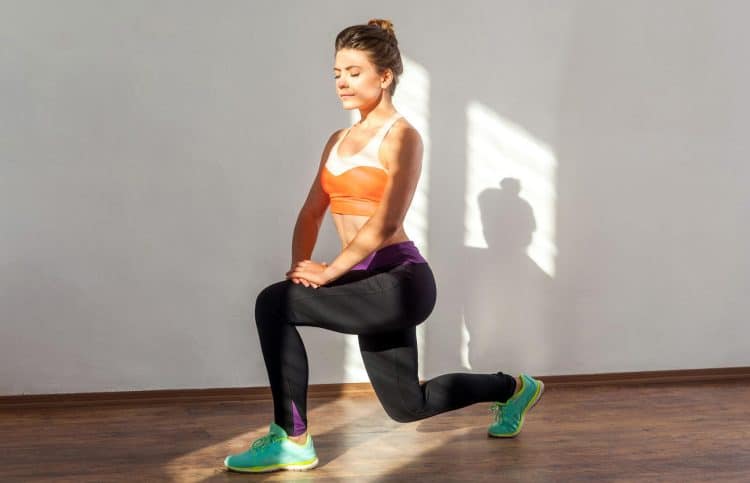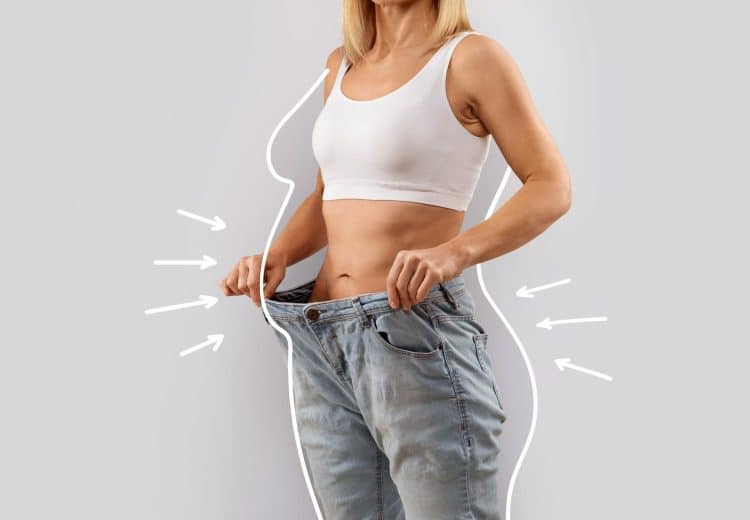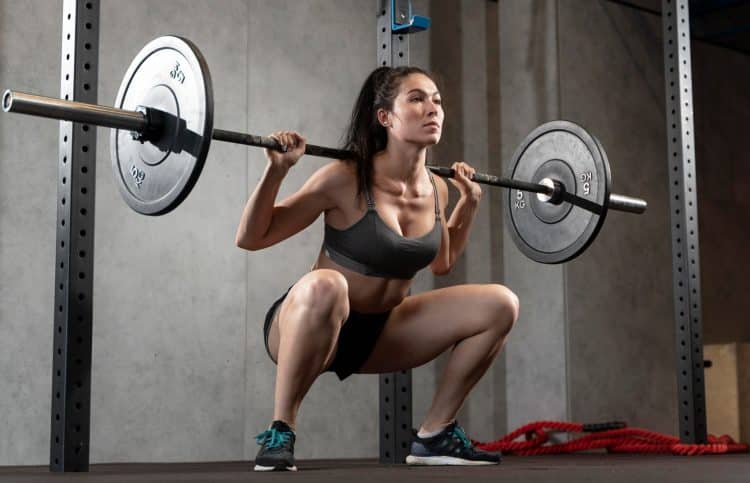I’ve been an advocate of strength training for women for over three decades. In the early 1990s, when many of my personal training contemporaries were mostly prescribing aerobics for their female clients, mine were squatting, deadlifting, and power-cleaning their way to fitness and leanness.
Needless to say, my clients’ results did nothing to change my opinions or methods. In fact, one of my first ever articles was called “Women, Weight, and Weight Training, published way back in 2007 (1).” I’ve repeated this pro-weights message so many times since that I may have it carved on my tombstone!
However, while I am still a huge fan of strength training for women and recognize its myriad health and aesthetic benefits, I also understand the value of cardio. After all, cardiovascular exercise is critical for heart, lung, and circulatory health and can help you lose weight and get lean (2).
It’s just a shame that it’s so time-consuming and, sometimes, butt-numbingly boring!
Thankfully, there is a way to enjoy the benefits of cardio while primarily lifting weights – Metabolic Training. This method uses strength training to deliver a cardio-like workout, giving you the best of both worlds.
In this article, I will explain what Metabolic Training is, outline its main benefits, and then provide you with some workouts to try.
Level Up Your Fitness: Join our 💪 strong community in Fitness Volt Newsletter. Get daily inspiration, expert-backed workouts, nutrition tips, the latest in strength sports, and the support you need to reach your goals. Subscribe for free!
What is a Metabolic Workout?
Metabolic workouts involve doing several compound resistance training exercises back-to-back. Rests between exercises are relatively short, which increases your heart rate like cardio without resorting to things like running, cycling, rowing, etc.
Here’s an example metabolic workout to illustrate how this training method works:
| # | Exercise | Work | Rest | Notes |
| 1 | Alternating lunges | 40 seconds | 20 seconds | Rest 2-3 minutes between rounds. Do 2-4 rounds according to your fitness. |
| 2 | Chest press | 40 seconds | 20 seconds | |
| 3 | Lat pulldown | 40 seconds | 20 seconds | |
| 4 | Dumbbell squat | 40 seconds | 20 seconds | |
| 5 | Shoulder press | 40 seconds | 20 seconds | |
| 6 | Seated row | 40 seconds | 20 seconds |
So, do each exercise in turn, resting just 20 seconds between movements. This should be long enough to move from one exercise to the next while ensuring your heart rate remains elevated.
Adjust the difficulty of the workout by:
- Increasing the duration of the work periods
- Shortening the rest periods, e.g., 10-15 seconds
- Shortening the rests between rounds
- Doing more rounds
- Using more demanding exercises
Metabolic workouts burn a lot of calories, both during and after your workout. Consequently, they deliver the benefits of both strength training and cardio, all in one time-efficient workout.
As such, metabolic workouts are ideal for people who don’t have the time to do strength training and cardio separately or find traditional non-stop cardio workouts unappealing.
These claims aren’t just marketing hyperbole, and numerous studies support the benefits and effects of metabolic workouts. A 2001 meta-analysis published on PubMed reveals that metabolic workouts are as effective as longer, conventional programs for fitness, strength, and fat loss (3).
Check out the next section for a more in-depth overview of the benefits of metabolic workouts!
Metabolic Workout Benefits
So, should you stop doing weights and cardio separately, making the move to metabolic workouts? Consider these benefits and then decide.
Burn More Calories
Metabolic workouts burn a lot of calories. Firstly, they involve large, compound exercises utilizing multiple muscle groups. Movements of this nature are very demanding and, as such, burn a high number of calories per minute. That’s why squats, despite being a strength exercise, leave you out of breath and with an elevated heart rate.
Secondly, regular strength training workouts typically involve more time resting than exercising. In contrast, metabolic workouts feature much less rest time. This non-stop activity means you’ll burn more calories per minute than conventional strength training.
Finally, metabolic workouts trigger a phenomenon called EPOC, which is short for excess post-exercise oxygen consumption. Also known as the afterburn effect, EPOC describes how your metabolism remains elevated for many hours after this type of training. This further increases your caloric expenditure.
According to studies, the EPOC effect can last as long as 36-48 hours, significantly increasing total energy expenditure (4).
In summary, you will burn more calories during and after your workout compared to conventional strength training and cardio.
Build/Preserve Muscle Mass
Cardio is good for your heart, lungs, and circulatory system, but it’s not so beneficial for your muscles. In fact, to make you more cardiovascularly efficient, doing a lot of cardio can lead to muscle atrophy or breakdown. Losing muscle will affect your functional strength and resting metabolic rate and is often detrimental to your appearance.
Strenuous strength training exercises like squats, deadlifts, push-ups, and pull-ups are the cornerstones of metabolic workouts. These exercises stimulate and overload your major muscles, triggering increases in strength and muscle growth (5). And even if you don’t build a lot of muscle, this form of workout will definitely prevent muscle atrophy.
This is an important benefit as fat loss diets often cause muscle loss. As such, any workout that preserves your existing muscle mass will reduce the metabolic slowdown that muscle atrophy can cause.
It’s worth noting that while metabolic training can build muscle, it’s not the best type of workout for this purpose. So, if you are serious about building bigger muscles, you should adopt a bodybuilding-type training program designed for that purpose.
Improved Cardiovascular Fitness
Cycling, running, swimming, and rowing are not the only ways to improve your cardiovascular fitness. Metabolic training also works. Doing back-to-back compound exercises with short rests in between will elevate your heart and breathing rate. As a result, your cardiovascular efficiency will improve (6).
Because of the principle of specificity, if you want to become a better runner, your training should revolve around running. The same is true for cyclists, swimmers, and other endurance athletes. But if you want to improve general fitness, metabolic training will help.
Improved Insulin Sensitivity and Glucose Control
Sedentarism, high levels of body fat, and eating too much sugar mean that many people suffer from insulin resistance and elevated blood glucose. This can cause many health issues, not least type 2 diabetes and weight gain.
High-intensity interval training, which shares many similarities with metabolic workouts, has been shown to improve insulin sensitivity and glucose regulation (7). This means the carbs you eat, which are then digested and converted into glucose, are more likely to end up in your muscles and liver and not your fat cells and blood.
Like EPOC, this effect lasts 24-48 hours, making it a valuable intervention for pre-diabetics, metabolic syndrome sufferers, and anyone interested in weight loss and better metabolic health.
Shorter Workouts
Lack of time is a significant barrier to consistent exercise. When life gets busy, our workouts are often the first casualty. However, metabolic workouts are relatively short, usually lasting 30-40 minutes or less. They also tend to be performed infrequently, typically three times a week.
This makes metabolic workouts an ideal option for time-pressed exercisers who struggle to exercise for longer or more often.
Level Up Your Fitness: Join our 💪 strong community in Fitness Volt Newsletter. Get daily inspiration, expert-backed workouts, nutrition tips, the latest in strength sports, and the support you need to reach your goals. Subscribe for free!
However, shorter, less frequent workouts don’t mean you will lose out on any fitness benefits. In contrast, a study by the American College of Sports Medicine suggests that metabolic training can deliver similar health and fitness benefits as conventional workouts (8).
With so many benefits on the table, it’s hard to think of a reason not to try metabolic workouts. They’re literally your all-in-one fitness and fat-loss solution! Keep reading to discover the best exercises for metabolic training.
The Best Metabolic Workout Exercises
You can use almost any compound strength training exercises for metabolic workouts. However, in my experience, some movements are better than others. So, to make designing your own metabolic workouts easier, in this section, I will share my favorite metabolic workout exercises.
Lower Body Exercises
Lower body exercises are critical for effective metabolic workouts. Firstly, they drive your heart and breathing rate sky-high, delivering that all-important cardiovascular effect. Secondly, they use multiple large muscles to burn a lot of calories.
As such, any metabolic workout should include several lower-body movements.
These are my favorite lower-body metabolic workout exercises:
- Barbell back squats
- Front squats
- Dumbbell squats
- Trap bar squats
- Air squats
- Kang squats
- Squat jumps
- Step-ups
- Lunges
- Walking lunges
- Reverse lunges
- Lateral lunges
- Rear foot elevated split squats
- Leg presses
- Deadlifts
- Romanian deadlifts
- Good mornings
- Kettlebell swings
- Power cleans
- Overhead medicine ball throws
Try to include both knee-dominant (squat variations) and hip-hinge movements (deadlift variations) in your workouts to work all major lower-body muscles.
Upper Body Pushing Exercises
Upper body pushing exercises work your chest, shoulders, and triceps. These movements are essential for strength, muscle size, and aesthetics. A lot of women find these exercises hard, but that’s precisely why you should do them. After all, no one ever got stronger doing easy workouts, right!?
My favorite upper body push metabolic workout exercises include:
- Kneeling push-ups
- Incline push-ups
- Push-ups
- Bench dips
- Chest press machine
- Barbell bench press
- Dumbbell bench press
- Dumbbell shoulder press
- Barbell shoulder press
- Shoulder press machine
- Pike push-ups
- Push-press
Upper Body Pulling Exercises
Pulling exercises work your back and biceps and are critical for muscle balance and better posture. Ideally, you should include as many pulls as pushes in your metabolic workouts. This will ensure you develop the muscles on the back of your body as much as those on the front.
Some of my favorite upper body pull metabolic workout exercises include:
- Assisted pull-ups/chin-ups
- Pull-ups/chin-ups
- Seated pike pull-ups
- Medium-grip lat pulldowns
- Neutral-grip lat pulldowns
- Inverted rows
- Seated rows
- Chest supported rows
- Single-arm dumbbell rows
- Bent over barbell rows
- T-bar rows
- Pendlay rows
Exercise Order
Your aim should always be to put as much effort into each exercise as possible. Subsequently, you should avoid doing similar exercises back-to-back. For example, if you did shoulder presses immediately followed by push-ups, your pushing muscles could become overly fatigued, limiting your performance.
Consequently, it’s generally best to adopt a legs/push/pull or legs/push/legs/pull order in your workouts. This prevents those overlaps and means you can put more effort into each exercise. In my experience, adopting one of these orders makes it easier to design enjoyable metabolic workouts. They also make metabolic workouts more manageable to perform.
But What About Abs and Arms?
Most abs (or core) and arms exercises are isolation in nature and are less useful for metabolic workouts. This is because a) they don’t have much impact on your cardiovascular system, and b) they don’t burn many calories. As such, we tend not to include them in metabolic workouts.
That doesn’t mean you have to forgo them, but it’s generally best to do them after your main metabolic workout. It’s also worth noting that your abs and core are indirectly involved in all compound exercises, so you may not need to train them separately.
That said, if you enjoy training your abs and arms, there is no reason not to. To that end, I’ll include an arms and abs finisher circuit in the next section. Feel free to tack onto the end of your main metabolic workout.
You now have everything you need to create your own metabolic workouts. But before you put pen to paper and start writing, please check out the next section, where you’ll find some sample metabolic training programs to try.
Sample Metabolic Workouts for Women
While I encourage you to design your own metabolic workouts, here are a few examples you can use for guidance, inspiration, or just to get you started. But, before you begin, make sure you prepare your muscles and joints for what you’re about to do with an appropriate warm-up.
Begin with 5-10 minutes of cardio, followed by dynamic mobility and flexibility exercises for your major muscles and joints. Finally, and especially if you are doing loaded strength training exercises, do a few easy reps of your main movements. This will provide an opportunity to practice your technique and dial in your training weights.
Note: Adjust the work and rest periods according to your current fitness and experience levels. You can also change exercises if necessary. It’s okay to do less and make your workout more manageable or more to make it more challenging. Listen to your body and become your own personal trainer.
Metabolic Workout for Women #1 – Bodyweight Only
This metabolic workout is ideal for home exercisers. Using your body weight for resistance means you can move quickly from one exercise to the next. Plus, because you don’t need much equipment, you can do this workout almost anywhere and anytime. This is one of my go-to workouts when I’m traveling or too busy to get to the gym.
| # | Exercise | Work | Rest | Notes |
| 1 | Air squats | 40 seconds | 20 seconds | Rest 2-3 minutes between rounds. Do 2-4 rounds according to your fitness. |
| 2 | Push-ups | 40 seconds | 20 seconds | |
| 3 | Seated pike push-ups | 40 seconds | 20 seconds | |
| 4 | Walking lunges | 40 seconds | 20 seconds | |
| 5 | Bench dips | 40 seconds | 20 seconds | |
| 6 | Inverted rows | 40 seconds | 20 seconds |
Metabolic Workout for Women #2 – Dumbbells
Dumbbells are an ideal training tool for metabolic workouts. They allow you to train your muscles from multiple angles while fine-tuning the difficulty of each exercise. Fixed-weight dumbbells are best, as you’ll waste valuable time changing the weights on adjustable dumbbells.
| # | Exercise | Work | Rest | Notes |
| 1 | Dumbbell step-ups | 50 seconds | 10 seconds | Rest 2-3 minutes between rounds. Do 2-4 rounds according to your fitness. |
| 2 | Dumbbell chest press | 50 seconds | 10 seconds | |
| 3 | Dumbbell Romanian deadlift | 50 seconds | 10 seconds | |
| 4 | Dumbbell bent-over row | 50 seconds | 10 seconds | |
| 5 | Dumbbell lunges | 50 seconds | 10 seconds | |
| 6 | Dumbbell shoulder press | 50 seconds | 10 seconds | |
| 7 | Dumbbell sumo deadlift | 50 seconds | 10 seconds | |
| 8 | Dumbbell chest-supported row | 50 seconds | 10 seconds |
Metabolic Workout for Women #3 – Freeweights
Barbells and dumbbells are a powerful combination! Use dumbbells for your lighter metabolic exercises and barbells for the heavier movements. However, take care to leave a couple of reps in the tank when you’re using barbells. A failed rep of squats or bench presses can cause serious injuries.
| # | Exercise | Work | Rest | Notes |
| 1 | Front squat | 10-15 reps | 15 seconds | Rest 2-3 minutes between rounds. Do 2-4 rounds according to your fitness. |
| 2 | Bent-over row | 10-15 reps | 15 seconds | |
| 3 | Bench press | 10-15 reps | 15 seconds | |
| 4 | Power clean | 10-15 reps | 15 seconds | |
| 5 | Push-press | 10-15 reps | 15 seconds | |
| 6 | Upright row | 10-15 reps | 15 seconds |
Metabolic Workout for Women #4 – Resistance Bands
Resistance bands (RB) are cheap, portable, and versatile, making them ideal for home or travel workouts. You can use resistance bands to replicate most freeweight and machine exercises, making them the perfect excuse-free tool for metabolic workouts. They’re also very easy on your joints, which is a bonus for any older exercisers.
| # | Exercise | Work | Rest | Notes |
| 1 | RB goblet squat | 30 seconds | 15 seconds | Rest 2-3 minutes between rounds. Do 2-4 rounds according to your fitness. |
| 2 | RB shoulder press | 30 seconds | 15 seconds | |
| 3 | RB Romanian deadlift | 30 seconds | 15 seconds | |
| 4 | RB lat pulldown | 30 seconds | 15 seconds | |
| 5 | RB chest press | 30 seconds | 15 seconds | |
| 6 | RB reverse lunge | 30 seconds | 15 seconds | |
| 7 | RB seated row | 30 seconds | 15 seconds |
Metabolic Workout for Women #5 – Mixed Modality
This program uses a range of exercises and equipment to deliver a varied, challenging, and effective metabolic workout. Don’t worry if you can’t use precisely the same training gear; just use whatever you have available. The point is to illustrate how you can mix and match training tools based on your preferences and what’s available.
| # | Exercise | Work | Rest | Notes |
| 1 | DB squat jumps | 6-10 | 15 seconds | Rest 2-3 minutes between rounds. Do 2-4 rounds according to your fitness. |
| 2 | Pull-ups | 6-10 | 15 seconds | |
| 3 | Nordic curls | 6-10 | 15 seconds | |
| 4 | Chest press machine | 12-15 | 15 seconds | |
| 5 | Kettlebell swings | 12-15 | 15 seconds | |
| 6 | Seated rows | 12-15 | 15 seconds | |
| 7 | Air squats | 20-30 | 15 seconds | |
| 8 | RB shoulder press | 20-30 | 15 seconds |
Metabolic Workout for Women #6 – Arms and Abs Finishing Circuit
While you don’t have to train your arms and abs separately, I know that many exercisers like to pay extra attention to these body parts. So, feel free to complete the following circuit after your main metabolic workout. However, it’s not compulsory as these muscles have already been trained, albeit indirectly.
| # | Exercise | Work | Rest | Notes |
| 1 | EZ bar curl | 10-12 | 15 seconds | Rest 2-3 minutes between rounds. Do 2-4 rounds according to your fitness. |
| 2 | EZ bar skull crusher | 10-12 | 15 seconds | |
| 3 | Biceps cable curls | 12-15 | 15 seconds | |
| 4 | Triceps cable pushdown | 12-15 | 15 seconds | |
| 5 | Cable crunches | 15-20 | 15 seconds | |
| 6 | Hanging knee raise | 15-20 | 15 seconds |
Closing Thoughts
Are you short on time? Do you struggle to fit strength training and cardio into your fitness schedule? Are you looking for a more efficient way to exercise?
Then metabolic workouts are for you!
This high-intensity training method uses strength training to condition your muscles while burning calories like a furnace and improving cardiovascular efficiency. In fact, it’s the ultimate in do-it-all workout strategies.
Is it the best way to work out? Probably not, but that’s because no such thing exists. After all, every person has unique goals, likes, and abilities; there is no “one size fits all” approach to exercise.
That said, metabolic training can be incredibly effective, and it deserves your attention. So, give it a try, and remember to post your feedback and questions in the comments section below.
More on Metabolic:
- Metabolic Diets: What Are They, and How Do They Work
- Metabolic Training for Fitness and Faster Fat Loss
References:
- DALE, P. (2007) Women, weight and weight training. Brian Mackenzie’s Successful Coaching, (ISSN 1745-7513/ 47/ November), p. 8-10
- Nystoriak MA, Bhatnagar A. Cardiovascular Effects and Benefits of Exercise. Front Cardiovasc Med. 2018 Sep 28;5:135. doi: 10.3389/fcvm.2018.00135. PMID: 30324108; PMCID: PMC6172294.
- Ramos-Campo DJ, Andreu Caravaca L, Martínez-Rodríguez A, Rubio-Arias JÁ. Effects of Resistance Circuit-Based Training on Body Composition, Strength and Cardiorespiratory Fitness: A Systematic Review and Meta-Analysis. Biology (Basel). 2021 Apr 28;10(5):37
- Schuenke MD, Mikat RP, McBride JM. Effect of an acute period of resistance exercise on excess post-exercise oxygen consumption: implications for body mass management. Eur J Appl Physiol. 2002 Mar;86(5):411-7. doi: 10.1007/s00421-001-0568-y. Epub 2002 Jan 29. PMID: 11882927.
- Alcaraz PE, Perez-Gomez J, Chavarrias M, Blazevich AJ. Similarity in adaptations to high-resistance circuit vs. traditional strength training in resistance-trained men. J Strength Cond Res. 2011 Sep;25(9):2519-27. doi: 10.1519/JSC.0b013e3182023a51. PMID: 21659889.
- McRae G, Payne A, Zelt JG, Scribbans TD, Jung ME, Little JP, Gurd BJ. Extremely low volume, whole-body aerobic-resistance training improves aerobic fitness and muscular endurance in females. Appl Physiol Nutr Metab. 2012 Dec;37(6):1124-31. doi: 10.1139/h2012-093. Epub 2012 Sep 20. PMID: 22994393.
- Terada T, Friesen A, Chahal BS, Bell GJ, McCargar LJ, Boulé NG. Feasibility and preliminary efficacy of high-intensity interval training in type 2 diabetes. Diabetes Res Clin Pract. 2013 Feb;99(2):120-9. doi: 10.1016/j.diabres.2012.10.019. Epub 2012 Nov 24. PMID: 23183390.
- Klika, Brett C.S.C.S., B.S.; Jordan, Chris M.S., C.S.C.S., NSCA-CPT, ACSM HFS/APT. HIGH-INTENSITY CIRCUIT TRAINING USING BODY WEIGHT: Maximum Results With Minimal Investment. ACSM’s Health & Fitness Journal 17(3):p 8-13, May/June 2013. | DOI: 10.1249/FIT.0b013e31828cb1e8








